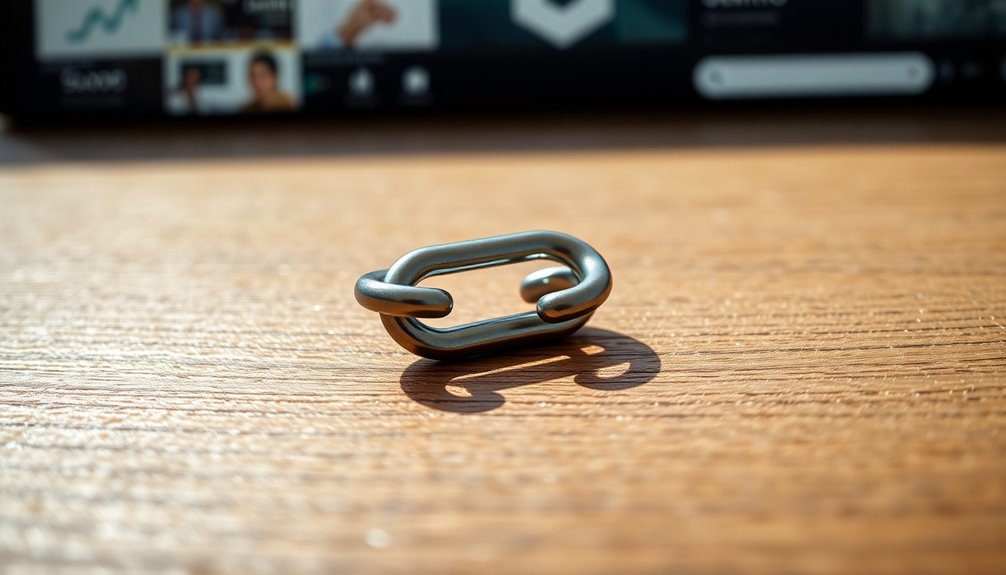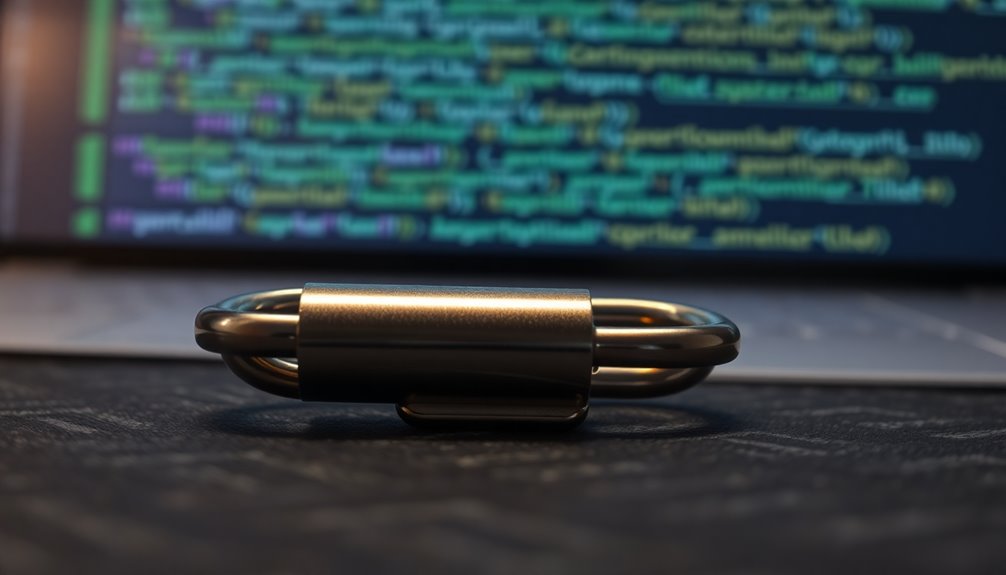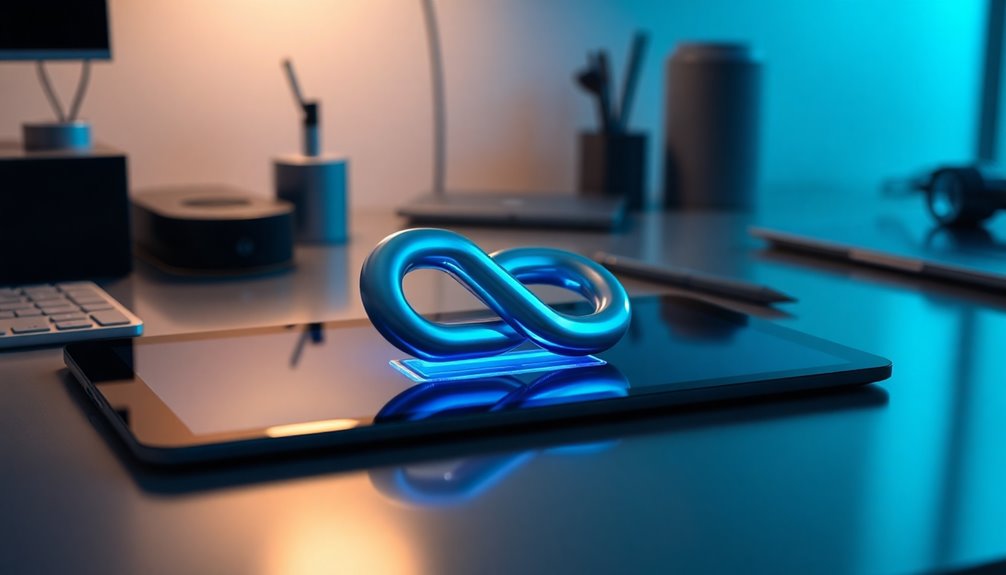An external link icon is a small graphic that signals a hyperlink leading away from the current website. These icons help you quickly identify which links will take you to different sites, enhancing your browsing experience. By indicating external links, they provide clarity and reduce confusion, promoting user trust. You know what to expect when clicking on these links, boosting engagement and satisfaction. Using consistent and accessible designs for these icons also improves navigation. If you want to explore the best practices and future trends related to these icons, there's plenty more to discover.
Definition of External Link Icon
An external link icon is a small graphic that signals a hyperlink will take you away from the current website. These icons act as visual cues, helping you quickly identify when a link leads to an external site or resource.
By using external link icons, web designers enhance your navigation experience, allowing you to manage your expectations about where a click will lead. Typically, these icons feature recognizable symbols like arrows or doorways, universally suggesting movement away from your current page. This design choice makes it easier for you to differentiate between internal and external links, reducing any potential confusion. You'll notice that implementing external link icons can greatly improve your overall user experience. Additionally, high-quality content linked through external icons can attract and retain users, further enhancing engagement.
Moreover, accessibility standards recommend pairing external link icons with descriptive text. This practice guarantees that all users, including those with disabilities, can understand the purpose of the links. Additionally, using external link icons can help improve your site's user engagement metrics, as they provide clear navigation cues that keep users informed. Furthermore, proper implementation of widget placement can enhance the visibility and effectiveness of these icons throughout your website.
Importance of External Link Icons
External link icons are essential for enhancing user trust and clarity in navigation. They signal when you're about to leave a site, helping you feel more in control of your online experience. Additionally, incorporating strong password policies can further bolster user confidence by ensuring their data is protected even when accessing external resources. Implementing security best practices not only protects users but also enhances the overall integrity of the website. Furthermore, regular updates of plugins and themes are crucial for maintaining security and ensuring that external links do not expose users to vulnerabilities.
User Trust Enhancement
Enhancing user trust is essential for any website, and one effective way to achieve this is by incorporating external link icons.
These icons serve as visual indicators, letting users know that they're about to navigate away from your site. This transparency is significant for building a trustworthy user experience.
When you clearly mark external links, you're helping users manage their expectations.
Here's how external link icons can enhance user trust:
- Visual cues: They indicate that a link directs to an external site, reducing uncertainty.
- Transparency: Users appreciate knowing where their clicks will take them, fostering trust.
- Engagement: Research shows that users are more likely to click on clearly labeled links, boosting engagement.
- Content differentiation: External link icons help users distinguish between internal and external content, increasing their sense of security.
Clarity in Navigation
Maneuvering a website should feel seamless, and clarity in navigation plays an important role in achieving that. External link icons act as crucial visual cues, alerting you when you're about to leave the current site. This not only manages your expectations but also enhances your overall experience. When you see these icons, you know you're dealing with external links, allowing you to make informed decisions about whether to proceed.
By clearly marking these links, external link icons build trust and transparency regarding content sources and privacy policies. You won't feel surprised by sudden navigations, as the icons prepare you for what's ahead.
Additionally, consistent icon design throughout a website can aid in quick recognition of external links, contributing to a cohesive visual experience. For users with varying levels of tech-savviness, these icons improve accessibility by providing additional context.
You'll appreciate the clarity in navigation that external link icons offer, as they empower you to navigate confidently and efficiently. Ultimately, implementing these icons fosters a smoother, more reliable browsing experience, making your time online more enjoyable.
Benefits of Using Icons

Using external link icons greatly enhances your user experience by clearly signaling when a link will take you to another site. This improved link clarity helps you trust the navigation process, allowing for more informed decisions about where to click. Ultimately, these icons encourage exploration and make your time on the website more satisfying. Additionally, intuitive navigation is essential for creating a seamless user experience, ensuring that visitors can easily find their way around the site. Implementing consistent margins and paddings in your layout can further improve the overall clarity and organization of the links. Personalized headers and footers can also enhance user engagement by providing essential navigation elements that guide users effectively.
Enhanced User Experience
Clarity in wayfinding is essential for a positive online experience, and external link icons play a crucial role in achieving that. By providing clear visual cues, these icons enhance user awareness and manage expectations when moving away from your site.
You'll notice several benefits that contribute to an enhanced user experience:
- Reduced Confusion: Users can easily identify where a link will take them, minimizing uncertainty.
- Informed Decisions: Icons allow users to decide if they want to follow a link without surprise transitions.
- Increased Engagement: When users understand the nature of the content, they're more likely to click on high-intent links.
- Accessibility Support: External link icons help guide users with disabilities, making it easier for them to grasp the context of links.
Incorporating external link icons into your site design not only streamlines wayfinding but also fosters a sense of trust.
Users appreciate knowing what to expect, leading to a smoother browsing experience. By enhancing user awareness, these icons contribute greatly to overall satisfaction and engagement with your content.
Improved Link Clarity
When you include external link icons on your website, you greatly enhance link clarity for your users. These icons serve as visual cues that clearly indicate when a link directs them to an external website. By doing so, you help manage user expectations regarding link destinations, which fosters a sense of security as they understand potential changes in their content environment.
With external link icons, you minimize surprise transitions, allowing users to make informed decisions about clicking links. This improved link clarity not only enhances the overall user experience but also aids users with disabilities by providing visual indicators that assist in traversing external resources more effectively.
Incorporating these icons into your web design supports better usability. Consistent and recognizable visuals help users quickly identify and differentiate between internal and external links. This clarity reduces confusion, making your site more user-friendly.
Ultimately, when users know what to expect from a link, they're more likely to engage with your content confidently. So, don't overlook the importance of external link icons; they're essential for improving link clarity and enhancing user satisfaction.
Increased User Trust
Boosting user trust is one of the key benefits of incorporating external link icons on your website. When you use these icons, you're clearly indicating that a link leads to an external site, which helps manage user expectations about leaving your domain. This transparency builds confidence and reduces anxiety about potential privacy or security issues.
Here are some ways external link icons contribute to increased user trust:
- Clear Indicators: They directly show users where they'll be heading when they click a link.
- Enhanced Security: Users feel more secure knowing they're informed about a link's destination.
- Higher Engagement: Research indicates that transparent communication about links increases click-through rates.
- Reliability Association: Users often connect specific icons with reputable websites, boosting trust in the content.
Best Practices for Implementation
Implementing best practices for external link icons can greatly enhance your website's usability. Start by guaranteeing consistency in your icon design across all external links. This helps users quickly recognize and understand the purpose of the links, improving their overall experience. Additionally, consider the importance of website security when linking to external sites, as users may be redirected to potentially harmful content. Implementing multi-factor authentication can also help safeguard user accounts, especially when linking to sensitive external resources.
Place icons strategically next to the link text to make them noticeable without being intrusive, allowing users to focus on your content. When it comes to sizing, make certain the icons are adequately sized—large enough to be visible but not so large that they distract from the main content.
It's also essential to adhere to accessibility standards. Provide sufficient contrast between the icons and the background, and always include alt text to confirm that users with disabilities can interact with external links effectively.
Consider implementing tooltips that appear on hover, giving users additional context about the links. This can help clarify the nature of the external content and assist in decision-making. Additionally, ensure your icons are visually appealing and user-friendly, as this can significantly enhance user engagement on your site.
Icon Design Considerations
Your website's icon design plays an essential role in user experience, especially for external links. When you create external link icons, you need to keep several considerations in mind to guarantee effectiveness and usability. Here are some key points to focus on:
- Bold and Minimal Aesthetics: Prioritize simplicity to enhance clarity and recognition, particularly at smaller sizes.
- Use SVG Format: This format allows your icons to scale without losing quality, ensuring they look sharp on all devices.
- Avoid Intricate Details: Keep designs straightforward; complex icons can become illegible when reduced, leading to user confusion. Additionally, consider implementing secure design practices to ensure icons do not compromise website integrity. Effective backup solutions can also safeguard your website's data, enhancing overall security.
- Consistency Across the Website: Uniform icon design helps users quickly identify external links, improving navigation.
Moreover, don't forget about accessibility. Ensure there's adequate color contrast and include alt text for all icons. Additionally, consider how typography choices can complement your icon design, enhancing overall site aesthetics.
These elements help all users interpret the icons effectively, making your website more inclusive. By paying attention to these design considerations, you'll create external link icons that enhance user experience and facilitate smoother interactions on your site.
Examples of External Link Icons
When it comes to external link icons, visual clarity is paramount. These icons serve as immediate indicators, helping you identify when a hyperlink will take you away from the current site. The use of external link icons enhances transparency, making your browsing experience smoother and more informed.
Common examples include the FontAwesome 'external-link-alt' and Material Icons 'open_in_new.' Both are widely recognized and effectively signal that a link directs you elsewhere. News websites like BBC and CNN often place these icons next to external sources, ensuring you know you're leaving their site when you click.
Educational institutions also rely on external link icons, marking links to academic articles and resources. This practice aids in navigation and builds trust with users, as you can clearly see where the link leads.
Government websites utilize similar icons for links to external services, ensuring clarity about leaving the official site. By incorporating these recognizable symbols, organizations improve user experience and maintain transparency.
Technical Implementation Steps

To effectively integrate external link icons into your website, start by choosing SVG format for its scalability and high quality across various devices. This guarantees your icons look sharp whether on a desktop or mobile screen.
Next, optimize the icons by removing unnecessary white space and customizing colors using design tools like Boxy SVG before uploading them to your web server.
After preparing your icons, utilize CSS to append them to your link text. This maintains a consistent appearance across your site.
Here are some steps to follow:
- Add specific CSS selectors to target your external link text.
- Use the 'rel' attribute, like 'rel=external', to enhance the semantic meaning of the links.
- Regularly test the icons' visibility to guarantee they communicate effectively without overwhelming your content.
- Update the icons as needed to keep them fresh and relevant.
User Experience Insights
Integrating external link icons into your website can greatly enhance user experience by providing clear visual cues for navigation. These icons act as indicators, signaling when users will leave your site, which helps manage expectations about where they're headed. By incorporating external link icons, you reduce confusion, allowing users to make informed decisions about clicking on links.
Research shows that users appreciate these icons because they increase trust. They transparently indicate different privacy policies and help users understand link destinations better. This straightforward visual cue is beneficial for users with varying levels of technical knowledge, as it complements the text in anchor links.
Moreover, consistent use of recognizable external link icons can prevent surprise navigations, making the browsing experience smoother and more predictable. This clarity is essential for enhancing overall user experience, as it empowers users to navigate confidently.
Lastly, external link icons contribute to compliance with accessibility standards. They assist users with disabilities by providing essential context, enabling them to understand and navigate external resources more effectively.
Future Trends in Iconography

As we look ahead to the future of iconography, the emphasis on user-centered design is becoming increasingly apparent.
You'll notice several emerging trends that will shape how icons, especially external link icons, are designed and utilized.
- SVG Dominance: Expect more icons to be in SVG format due to their scalability and high-quality rendering across various devices.
- Minimalism: Designers will lean towards minimalist and intuitive representations, minimizing visual clutter while enhancing usability.
- Accessibility Focus: Future iconography will prioritize accessibility, ensuring icons are easily recognizable and accompanied by descriptive text or alt attributes.
- Animated Icons: The integration of animated icons could offer dynamic feedback, boosting user engagement when interacting with external links.
Conclusion
Incorporating an external link icon is a smart move for enhancing user experience on your website. It helps users quickly identify links leading away from your page, keeping them informed and engaged. By following best practices and focusing on thoughtful design, you can guarantee your icons serve their purpose effectively. Remember, a picture's worth a thousand words, so don't underestimate the power of these visual cues in guiding your audience seamlessly through their online journey.


